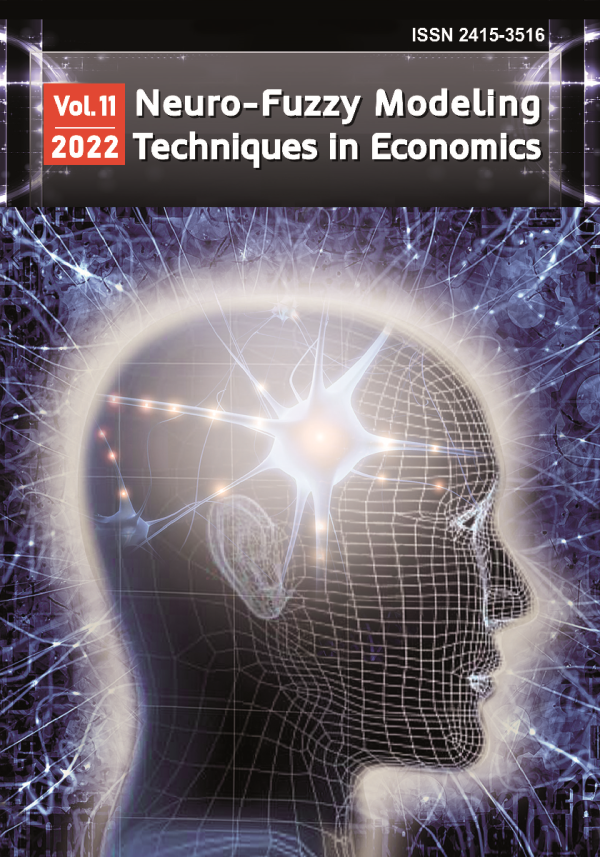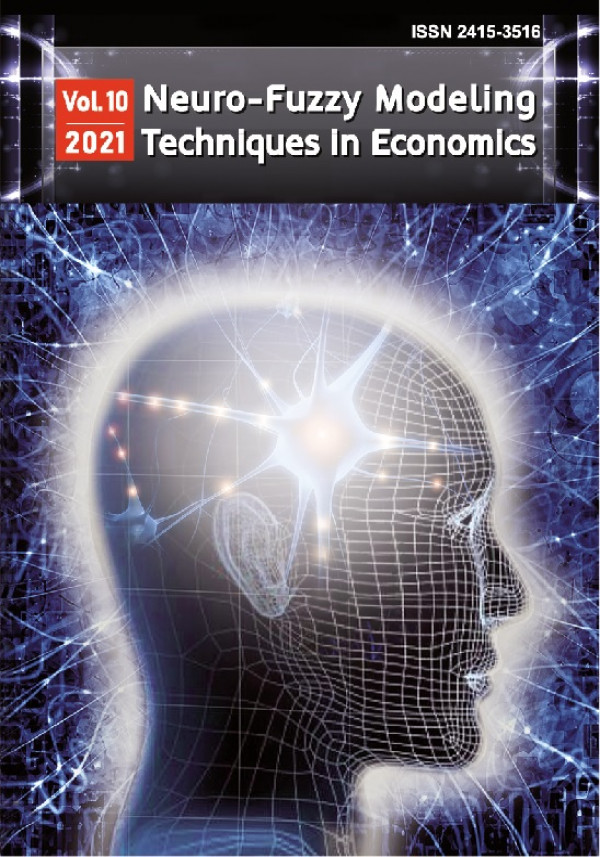
Neuro-Fuzzy Modeling Techniques in Economics
ISSN 2415-3516
EU countries clustering for the state of food security using machine learning techniques
DOI:
10.33111/nfmte.2021.086
Анотація:
Abstract: The food security problem has emerged from the growing pressure of demographic problem and global inequality. Overall, the state of food security is optimal in the EU. This was achieved due to effective implementation of regulatory initiatives regarding EU countries food self-sufficiency and intra-EU food market protection. The purpose of the research paper was to cluster EU countries in terms of food security level using advanced mathematical modeling tools. To this end, we selected 5 food security factors (FAO Food production index, Total factor productivity in agriculture, Per capita agricultural expenditure, Consumer prices food, Net trade food index) to which we applied the following cluster analysis algorithms (self-organizing maps, dendrograms, k-means and k-medoids clustering). As a result of the conducted experimental research, it was found that self-organizing maps and dendrograms methods to be better suited for data visualization, whereas k-means and k-medoids give more accurate and detailed solutions. The obtained results gave us an opportunity to define the advantages and disadvantages of the selected clustering methods, as well as to present agripolicy recommendations for different groups of EU countries.
Ключові слова:
Key words: cluster analysis, food security, self-organizing map, hierarchical clustering, k-means, k-medoids
УДК:
UDC:
JEL: C38 C88 L66 Q18
To cite paper
In APA style
Kobets, V., & Novak, O. (2021). EU countries clustering for the state of food security using machine learning techniques. Neuro-Fuzzy Modeling Techniques in Economics, 10, 86-118. http://doi.org/10.33111/nfmte.2021.086
In MON style
Кобець В., Новак О. EU countries clustering for the state of food security using machine learning techniques. Нейро-нечіткі технології моделювання в економіці. 2021. № 10. С. 86-118. http://doi.org/10.33111/nfmte.2021.086 (дата звернення: 28.11.2025).
With transliteration
Kobets, V., Novak, O. (2021) EU countries clustering for the state of food security using machine learning techniques. Neuro-Fuzzy Modeling Techniques in Economics, no. 10. pp. 86-118. http://doi.org/10.33111/nfmte.2021.086 (accessed 28 Nov 2025).
 # 10 / 2021
# 10 / 2021
Download Paper

830
Views
176
Downloads
6
Cited by
- Sen, A. (1983). Poverty and famines: An essay on entitlement and deprivation. Oxford university press. https://doi.org/10.1093/0198284632.001.0001
- Friedmann, Н., & McMichael, P. (1989). Agriculture and the state system: the rise and fall of national agricultures, 1870 to the present. Sociologia Ruralis, 29(2), 93-117. https://doi.org/10.1111/j.1467-9523.1989.tb00360.x
- FAO. (1996, November 13-17). Rome Declaration on World Food Security. https://www.fao.org/3/w3613e/w3613e00.htm
- Committee on World Food Security. (2012). CFS 39 Final Report (CFS 2012/39/4). FAO. http://www.fao.org/3/MD776E/MD776E.pdf
- IFC. (2021). International Food Safety Forum. https://www.ifc.org/wps/wcm/connect/industry_ext_content/ifc_external_corporate_site/agribusiness/events/food+safety+forum
- Buiak, L., Bashutska, O., Pryshliak, K., Hryhorkiv, V., Hryhorkiv, M., & Kobets, V. (2020). Models of Rental Payments Formation for Agricultural Land Plots Taking into Account the Ecological Level of Economy. In Proceedings of 2020 10th International Conference on Advanced Computer Information Technologies (pp. 204-208). IEEE. https://doi.org/10.1109/ACIT49673.2020.9208959
- Wittman, H. (2011). Food Sovereignty: A new Rights Framework for Food and Nature? Environment and Society, 2(1), 87-105. https://doi.org/10.3167/ares.2011.020106
- Maxwell, S. (2001). The Evolution of Thinking about Food Security. In S. Devereux, & S. Maxwell (Eds.), Food Security in Sub-Saharan Africa (pp. 13-31). ITDG Publishing. https://doi.org/10.3362/9781780440170.002
- Novikov, Ye.Yu. (2011). Zabezpechennia hlobalnoi prodovolchoi bezpeky v umovakh pryskorennia klimatychnykh zmin [Ensuring global food security in the context of accelerating climate change]. Kultura narodov Prychernomoria (Culture of the peoples of the Black Sea region), 216, 78-81. http://dspace.nbuv.gov.ua/handle/123456789/64963 [in Ukrainian]
- Fischler, F., Wilkinson, D., & Benton, T., et al. (2015). The role of research in global food and nutrition security. Expo 2015 EU Scientific Steering Committee. https://europa.eu/expo2015/sites/default/files/files/FINAL_Expo-Discussion-paper_lowQ(1).pdf
- Eurostat. (2017, October 17). EU trade in food. https://ec.europa.eu/eurostat/web/products-eurostat-news/-/edn-20171016-1
- Kaminskyi, A., Nehrey, M., & Komar, M. (2019). Agro-economic models: a review and directions for research. Periodicals of Engineering and Natural Sciences, 7(2), 702-711. https://doi.org/10.21533/pen.v7i2.579
- Kaminskyi, A. B., Nehrey, M. V., & Zomchak, L. M. (2021). COVID-19: crisis or new opportunities time for the agricultural sector of Ukraine. IOP Conference Series: Earth and Environmental Science, 628(1), Article 012031. https://doi.org/10.1088/1755-1315/628/1/012031
- Hossaina, M., Mullally, C., & Asadullah, M.N. (2019). Alternatives to calorie-based indicators of food security: An application of machine learning methods. Food Policy, 84, 77–91. https://doi.org/10.1016/j.foodpol.2019.03.001
- Nica-Avram, G., Harvey, J., Smith, G., Smith, A., & Goulding, J. (2021). Identifying food insecurity in food sharing networks via machine learning. Journal of Business Research, 131, 469–484. https://doi.org/10.1016/j.jbusres.2020.09.028
- Kozlovskyi, S., Khadzhynov, I., Mohylova, A., Tomchuk, V., & Kozlovskyi, A. (2018). The concept model for ensuring the economic security in the agrarian sector. Management theory and Studies for Rural Business and Infrastructure Development, 40(4), 531-547. https://doi.org/10.15544/mts.2018.47
- Tan, P., Steinbach, M., & Kumar, V. (2005). Cluster analysis: basic concepts and algorithms. In Introduction to data mining (1st ed., pp. 487-568). Pearson Addison Wesley. https://www-users.cse.umn.edu/~kumar001/dmbook/ch8.pdf
- Pistunov, I.M., Antoniuk., O., & Turchaninova, I. (2008). Klasternyi analiz v ekonomitsi [Cluster analysis in economics]. National Mining University. [in Ukrainian]
- Erickson, K. (2018). Introduction to Cluster Analysis. https://cnls.lanl.gov/external/qbio2018/Slides/Cluster_Lab_June18/qBio_Clustering_Lecture.pdf
- Kobets, V., Yatsenko, V., & Voynarenko, M. (2019). Cluster analysis of countries inequality due to IT development. CEUR Workshop Proceedings, 2393, 406–421. http://ceur-ws.org/Vol-2393/paper_341.pdf
- Kobets, V., Yatsenko, V., & Voynarenko, M. (2020). Cluster Analysis of Countries Inequality Due to IT Development Through Macros Application. In V. Ermolayev, F. Mallet, V. Yakovyna, H. Mayr, & A. Spivakovsky (Eds.), Communications in Computer and Information Science: Vol. 1175. Information and Communication Technologies in Education, Research, and Industrial Applications (pp. 415–439). Springer. https://doi.org/10.1007/978-3-030-39459-2_19
- Tishchenko, O.M. (2010). Klastery yak vektor rozvytku ekonomiky: orhanizatsiia, sutnist i kontseptsii [Clusters as a vector of economic development: organization, essence and concepts]. Teoretychni ta prykladni pytannia ekonomiky (Theoretical and applied issues of economics), 21, 74-80. http://tppe.econom.univ.kiev.ua/data/2010_21/Zb21_10.pdf [in Ukrainian]
- Jipkate, B.R., & Gohokar, V.V. (2012). A comparative analysis of fuzzy c-means clustering and k means clustering algorithms. International Journal of Computational Engineering Research, 2(3), 737-739. http://www.ijceronline.com/papers/Vol2_issue3/T023737739.pdf
- Hartigan, J.A., & Wong, M.A. (1979). A k-means clustering algorithm. Journal of the Royal Statistical Society. Series C (Applied Statistics), 28(1), 100–108. https://doi.org/10.2307/2346830
- NCSS. (2020). K-Means Clustering. Chapter 446. In NCSS Statistical Software (pp. 446-1–446-8). NCSS. Retrieved July 1, 2020, from https://www.ncss.com/wp-content/themes/ncss/pdf/Procedures/NCSS/K-Means_Clustering.pdf
- NCSS. (2020). Medoid Partitioning. Chapter 447. In NCSS Statistical Software (pp. 447-1–447-11). NCSS. Retrieved July 1, 2020, from https://www.ncss.com/wp-content/themes/ncss/pdf/Procedures/NCSS/Medoid_Partitioning.pdf
- FAOSTAT. (2020). Suite of Food Security Indicators [Data set]. Retrieved July 1, 2020, from http://www.fao.org/faostat/en/#data/FS
- Van Dijk, M., & Meijerink, G. (2014). A review of global food security scenario and assessment studies: results, gaps and research priorities. Foodsecure, February, Article 20. https://www.wecr.wur.nl/WECRGeneral/FoodSecurePublications/20_Dijk_Meijerink_review-global-food.pdf
- World Bank. (2020). Food production index [Data set]. Retrieved July 1, 2020, from https://data.worldbank.org/indicator/AG.PRD.FOOD.XD
- European Commission. (2020). CAP CONTEXT INDICATORS – 2019 update [Data set]. Retrieved July 1, 2020, from https://agriculture.ec.europa.eu/document/download/fd20e275-115a-4bdd-af9e-364650794270_en?filename=cap-context-indicators-table_2019_en_0_0.pdf
- Van Ark, B., de Vries, K., & Jäger, K. (2018). Is Europe’s Productivity Glass Half Full or Half Empty? Intereconomics, 53(2), 53-58. https://doi.org/10.1007/s10272-018-0721-z
- International Food Policy Research Institute. (2018). Statistics on Public Expenditures for Economic Development (SPEED). In Food policy indicators: tracking change (pp. 106-111). USAID. http://ebrary.ifpri.org/utils/getfile/collection/p15738coll2/id/132327/filename/133362.pdf
- Google Drive. (2021, August 1). Data set for Cluster analysis for the State of Food Security [Data set]. https://drive.google.com/file/d/1dVpjcBDYpDi05r77pw5bb7CmLBEgs8wG/view?usp=sharing

